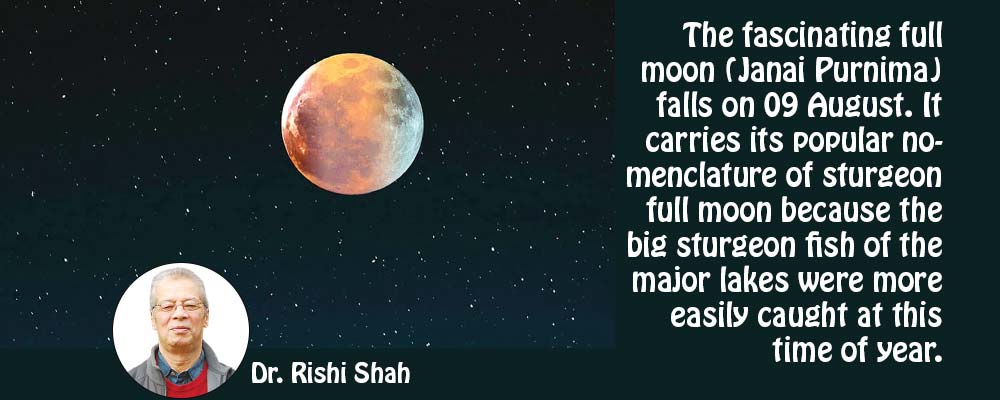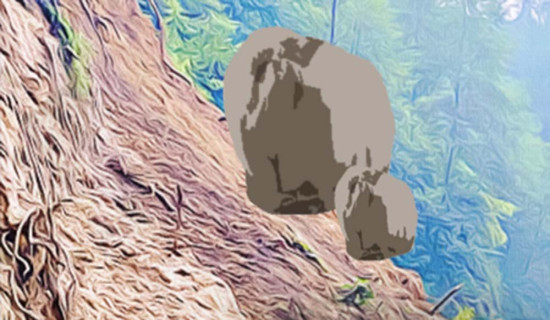- Friday, 8 August 2025
NIGHT SKY IN AUGUST 2025
Planets Align This Month
The short and nimble night skies of this warm summer month would entice and cherish avid sky-gazers with planets, stars, constellations, and other extraordinary entities that could be observed outstandingly all over the heavens. The elusive planet Mercury could perhaps be briefly discerned before sunup at dawn low in the eastern sky towards the end of the month. It is fleeting through the southern section of the faint constellation Cancer (crab). Mercury reaches its greatest western elongation mischievously from the Sun on 19 August. It could be best viewed since it will sit highest above the horizon in the morning sky. The resplendent ruddy planet Mars can be marked merrily in the western sky after sunset for a meaningful moment.
It would move through the compelling constellation Virgo (maiden) towards the horizon and be evanescent eerily. Planet Venus can be appreciated appealingly during wee hours after midnight in the eastern sky before sunrise. It is gleaming gloriously with the scintillated stars of Gemini (twins). Planet Jupiter would be shimmering to the east of Venus in the constellation Gemini. It would be perceived late after midnight till before day commences in the eastern sky. Venus and Jupiter will make a peerlessly terrific tight tryst on 12 August. Mars is obviously available to the east of the marvellous and flamboyant stars Regulus (Magha) and Subra. Uranus and Venus are placidly present above the abnormal star Aldebaran. Subra is a multiple star in the constellation Leo (lion), west of Regulus, basically 130 light-years away, where it is represented as one of the lion's forepaws. Regulus appears single but is actually a quirky quadruple star composed of four stars that are organised into two pairs.
They are only 79 light-years from us. Regulus and five dimmer stars are collectively called the Sickle asterism that is ardently avouched as the head of the legendary lion. The red giant star Aldebaran, with a radius 45 times the Sun's and a whopping 400 times more aflame and sparkling at a weirdly 3700 degrees Celsius, is dangerously depleting its supply of hydrogen in the core. The star twirls slowly, needing 520 days to rotate once. It is a fierce 67 light-years away. Ringed planet Saturn, seated firmly below the bluish planet Neptune, could be admired awesomely in the eastern sky after nightfall. They would be aloft in the southern sky late at night and then dip down towards the southwestern horizon and fade from sight as the day would begin. They are proudly placed below the charming circlet asterism of the charismatic constellation Pisces (fishes).
They are embracing each other during a remarkable rigid rendezvous on 06 August. To the west of Neptune and Saturn, the amazing asteroid 2 Pallas can be chased in the diminutive constellation Delphinus (dolphin) that inhabits the sprawling superb space abounding with petit constellations like Equuleus (colt), Sagitta (arrow), and Vulpecula (fox) as a shiny speck of light from the eastern sky at evening towards the uppermost realm above the western horizon by midnight. It would be then later lost in solar brilliance. Pallas, with a diameter of a graceful 525 kilometres, was recognised as the second asteroid by German astronomer Heinrich Olbers in 1802. Its orbital period is elegantly 4.611 years. Glaringly glowing to the west of Venus, the far-flung greyish planet Uranus could be spotted among the sizzling stars of the constellation Taurus (bull) in the eastern sky late at night. By dawn break it would be hovering above the eastern horizon. The arcane star Aldebaran (Rohini) would be dramatically dazzling below Uranus.
The fascinating full moon (Janai Purnima) falls on 09 August. It carries its popular nomenclature of sturgeon full moon because the big sturgeon fish of the major lakes were more easily caught at this time of year. The new mystic moon betides on 23 August (Fathers’ Day). Festivals of Gai Jatra, Krishna Asthami, Teej (especially for ladies), and Rishi Panchami are celebrated with veneration and joy on 10, 16, 26, and 28 August, respectively. The peculiar Perseid meteor shower is one of the most prolific meteor showers to watch and enjoy. It would be displaying up to 60 meteors per hour at its maximum.
It is allegedly produced by comet 109P/Swift-Tuttle with an orbital period of circa 134 years, which was identified in 1862. American astronomers Lewis Swift and Horace Tuttle visually affirmed it. Currently it is approximately 6.432 billion kilometres away and dwelling daintily in the stretched constellation Hydra (sea serpent). The Perseids are famous for offering copious coruscating meteors. The shower runs annually from 17 July to 24 August. It peaks this year on the night of 12 August till the morning of 13 August. The waning gibbous moon (fairly 83 percent luminous and 19 days old) would not block out the brightest meteors this year. Patient onlookers may catch fulgent shooting stars.
Excellent heeding will be obtained from dark neighbourhoods after midnight. Meteors will exude from the radiant point residing bewilderingly in the cute constellation Perseus (legendary hero). Meteor showers arise when Earth races through streams of debris left behind in the wake of comets and asteroids. Over time, the pieces of grit-like particles distribute themselves along the length of the parent object's trajectory around the solar system. Lambent meteors are relished whenever these petit dregs collide with the earth's atmosphere, typically burning up at an altitude of barely 70 to 100 kilometres during pre-dawn hours.
The baffling birth of a strange solar system has been witnessed in the first ALMA image of HOPS-315, depicting a nascent baby star in evolution. Around this sun-like star just 1300 light-years away, a fertile family of planets has been verified in its earliest seconds of conception. They are picked up in the odd Orion Nebula.
The stars remind us of our sun during infancy. The majestic Orion Nebula (M42) is the nearest star nursery to Earth, located roughly 1350 light-years away with an age of simply 2 million years. The billowing colourful clouds of gas and dust are scouted up in the famed iconic constellation Orion (hunter), spreading mesmerizingly below Aldebaran.
It has captivated civilisations around the world. The ancient Maya of Mesoamerica interpreted the nebula as the cosmic fire of creation. It is bizarrely believed that the Orion Nebula generates sufficient indispensable water molecules to fill up Earth's oceans queerly 60 times over in one day. Scientists found signs of minerals starting to solidify around HOPS-315, signifying sensationally the very first stage of a planet. This is the first time such a process has been directly delved into outside our own solar system.
The discovery was made using the powerful James Webb Space Telescope (JWST) and confirmed by Chile's ALMA (Atacama Large Millimetre/sub-millimetre Array). They were concentrated around the disc like our asteroid belt, which may give indications about how Earth and Jupiter began conjugating in a confounding manner.
Astronomers analysed the infrared flow of dusty detritus left over from the HOPS-315 and found comely but hot materials that would eventually form paltry planets deemed as seeds around which new planets will develop. These freak findings can distinctly divulge the first steps of planet formation. They even contain clues about how our own solar system was concocted.
Stars themselves cohere from dense clouds of molecular gas and rubble in the cosmos. When their clump is definitely dense enough, it collapses under gravity to shape the new star. As the baby star spins, the matter around it coalesces into a disc that whirls around and feeds the star's growth. When the star is huge enough, its protostellar winds push the materials. It continues to revolve, cooling and sticking together.
The newborn planet was espied at a distance of a sheer 329 million kilometres from the host star. This span mimics the gap of the asteroid belt from the Sun between Mars and Jupiter. Seeking seriously and involving intensely those that have survived intact since they were questionably born 4.5 billion years ago, like investigating asteroids and comets that have not undergone changes as the planets are essential.
An orange dwarf star, described in detail as having a scant 60 percent of the mass of the Sun, HOPS-315 is still growing. In one million years, it would accumulate the same mass as our Sun. Substantial similarity between the two would help us understand the embryonic years of our solar system.
(The author is an academician at NAST and patron of Nepal Astronomical Society or NASO)
















